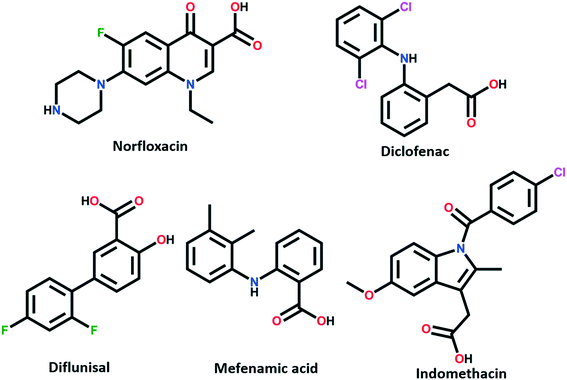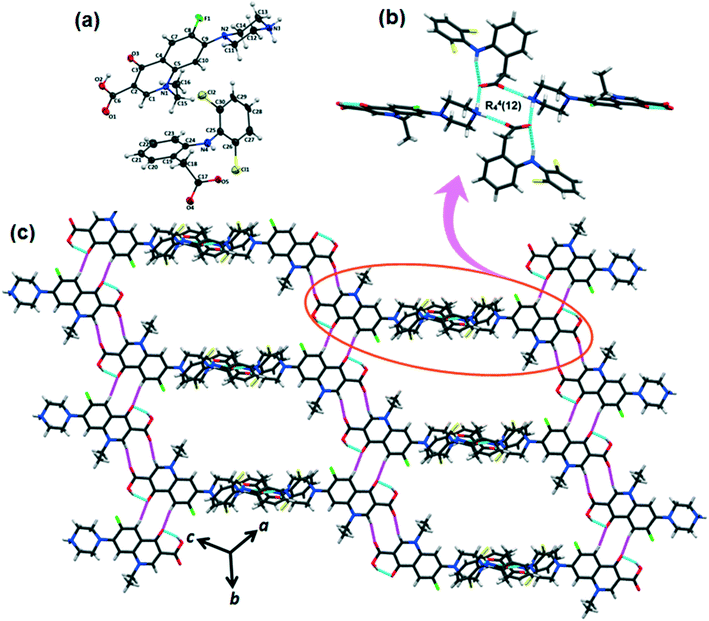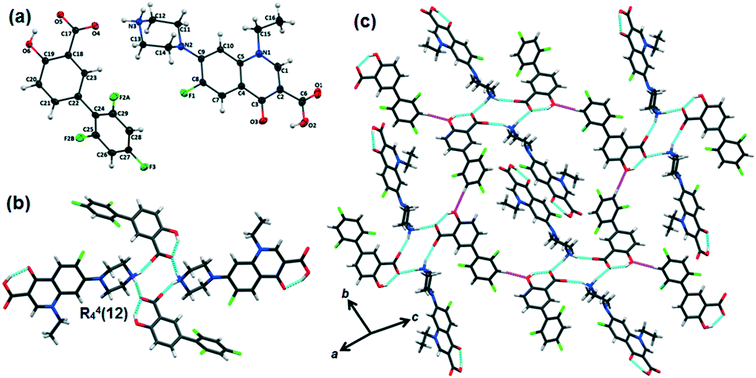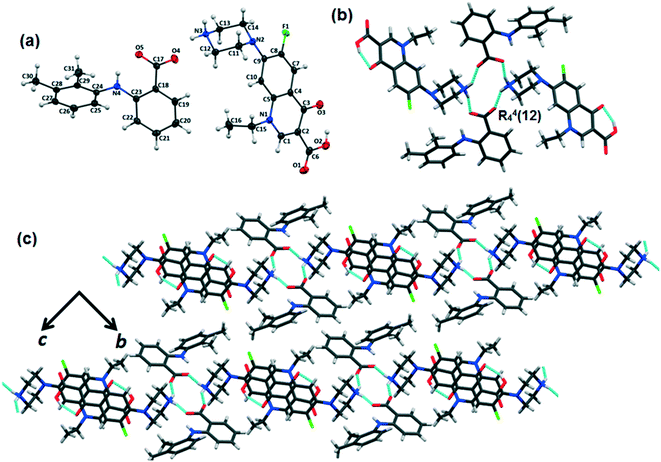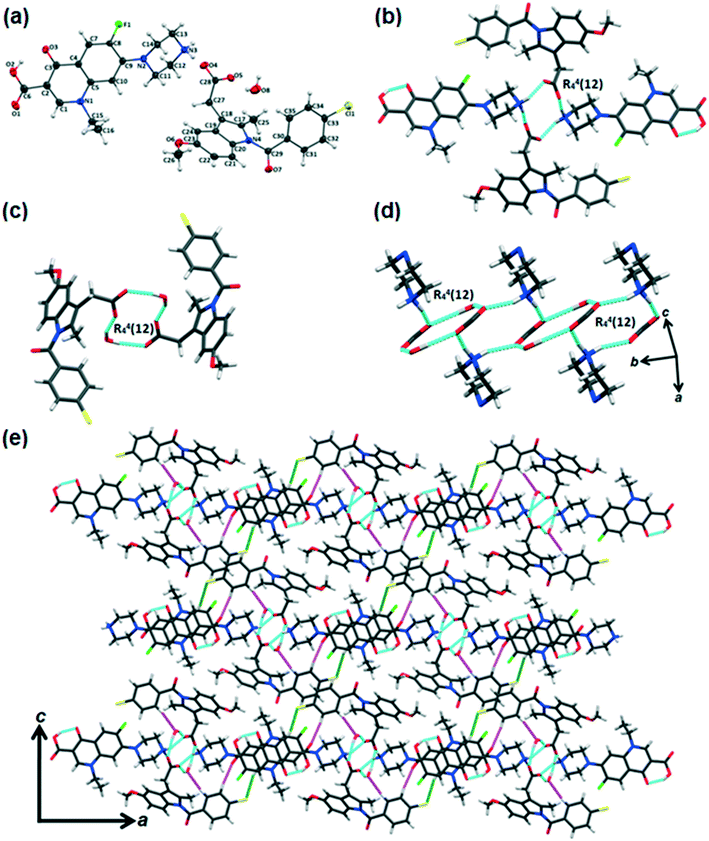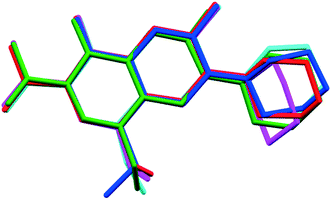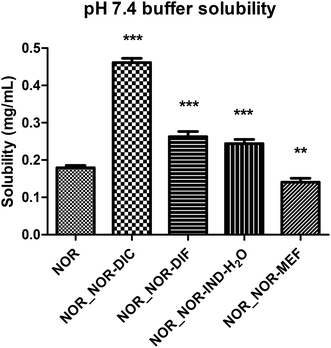Multidrug salt forms of norfloxacin with non-steroidal anti-inflammatory drugs: solubility and membrane permeability studies†
Biswajit
Bhattacharya
*a,
Amit
Mondal
a,
Saundray Raj
Soni
b,
Susobhan
Das
a,
Surojit
Bhunia
a,
K.
Bal Raju
a,
Animesh
Ghosh
 *b and
C.
Malla Reddy
*b and
C.
Malla Reddy
 *a
*a
aDepartment of Chemical Sciences, Indian Institute of Science Education and Research (IISER) Kolkata, Mohanpur Campus, Mohanpur, Nadia-741246, West Bengal, India. E-mail: biswajit.bhattacharya.chem@gmail.com; cmallareddy@gmail.com
bDepartment of Pharmaceutical Sciences and Technology, Birla Institute of Technology, Mesra, Ranchi 835215, India. E-mail: aghosh@bitmesra.ac.in
First published on 20th September 2018
Abstract
Multidrug solids have potential to efficiently treat and control a plethora of medical conditions. With the objective of discovering multidrug forms, three new multidrug salts and a salt hydrate of an antibacterial drug, norfloxacin (BCS class IV drug) with four non-steroidal anti-inflammatory drugs (NSAIDs, BCS class II drugs), diclofenac (NOR–DIC), diflunisal (NOR–DIF), mefenamic acid (NOR–MEF) and indomethacin (NOR–IND–H2O), were prepared by liquid-assisted grinding. Single crystal X-ray diffraction (SCXRD) reveals that proton transfer from the carboxylic acid of the NSAIDs to the piperazinyl group of norfloxacin occurs in all the salts to form a robust tetrameric R44 (12) ring piperazine–carboxylate synthon by N+–H⋯O− bonding. Studies on the equilibrium solubility in different biological pH buffer solutions and membrane permeability have been carried out and a comparison is made with those of the parent drugs. A significant enhancement of norfloxacin solubility was observed for the pH 7.4 buffer solution in all the binary systems with the exception of the NOR–MEF salt. Also, a cumulative amount of NOR–DIF and NOR–IND–H2O binary systems show remarkable improvement in diffusion behavior compared to that of the individual pure drugs. Thus, the increasing physicochemical properties through the combined effect of improved solubility and permeability leads to the enhancement of bioavailability, which has implications that overcome the formulation-related problems of APIs.
Introduction
Tuning the functional properties of promising crystalline solids is the ‘holy grail’ of state-of-the art crystal engineering research,1–5 and in this context, designing multicomponent crystals of active pharmaceutical ingredients (APIs), especially molecular and ionic co-crystals, and salts with GRAS (generally recognized as safe) listed coformers has taken the limelight of interest nowadays.6–9 The new solid forms can improve the pertinent physicochemical properties of APIs such as stability, solubility, bioavailability, mechanical properties, etc., without affecting the chemical integrity of the drugs.10–17 A natural and convenient extension of pharmaceutical co-crystals to multidrug multicomponent crystals (which consist of different API molecules) opens a new era for the development of combinational therapies.18–24 This class of crystals may not only provide technological advantages but also have potential for the development of medication compliance in the patient's long term drug therapy compared to multicomponent crystals of single drug molecules.19,20 Recently, Gopi et al. also reported a drug–drug salt hydrate of norfloxacin and sulfathiazole with enhanced solubility and improved diffusion behavior.21 Perlovich et al. published two pharmaceutical co-crystals of diflunisal and diclofenac with theophylline showing improved solubility and intrinsic dissolution rates compared to the corresponding pure APIs.22Almost 50% of drugs in the pharmaceutical industry pipeline face major formulation-related problems of low water solubility, which normally limits absorption in the gastrointestinal (GI) tract, decreasing the bioavailability of an API.25 In this regard, salt formation is the traditional and widely practiced technology to improve the dissolution and bioavailability of poorly soluble drugs because the solubility enhancement is generally almost 100–1000 fold in salts.26 Consequently, more than 50% of APIs are marketed as salts. Although several multidrug co-crystals have been reported so far, to date, there have been only a few examples of multidrug salts whose physicochemical properties were studied.21,27 We have recently reported two new drug–drug salt forms of ciprofloxacin (CIP) with non-steroidal anti-inflammatory drugs (NSAIDs), diflunisal (CIP/DIF) and indoprofen (CIP/INDP/H2O).28 In continuation of our previous work to prepare multidrug crystals for combination drug therapy by a crystal engineering approach, here, we have chosen norfloxacin (NOR) with different NSAIDs. Norfloxacin belongs to a family of broad-spectrum oral antibiotics called fluoroquinolones, drugs that are extensively prescribed in respiratory and urinary tract infections for the treatment of Gram-negative as well as Gram-positive bacterial infections.29,30 NSAIDs are one of the most widely used classes of drugs that reduce pain, decrease fever, and in higher doses, alleviate inflammation by inhibiting the enzymes cyclooxygenase-1 (COX-1) and cyclooxygenase-2 (COX-2).31 Generally, doctors prescribe antibiotics along with NSAIDs to treat stomach ulcer, chronic bacterial infection and an unremitting inflammatory response.32 According to the Biopharmaceutics Classification System (BCS), norfloxacin is a class-IV drug with low solubility and low permeability, whereas the NSAIDs used here belong to the BCS class-II and show low solubility and high permeability.33–35 Our goal is to be able to develop new collective properties by binding antibiotics and NSAIDs together within the same crystal packing, in order to achieve new and better physical properties with respect to those of the original solid.36 In this study, we report four new multidrug salts, including a salt hydrate, of norfloxacin (NOR) with four NSAIDs, diclofenac (DIC), diflunisal (DIF), mefenamic acid (MEF) and indomethacin (IND) (Scheme 1). The salts are characterized by single crystal X-ray diffraction (SCXRD), powder X-ray diffraction (PXRD), Fourier transform infrared (FTIR) spectroscopy, differential scanning calorimetry (DSC) and thermogravimetric analysis (TGA). Pharmaceutically significant properties such as solubility in different biological pH buffer solutions and diffusion behavior are examined carefully.
Experimental section
All APIs (NOR, DIC, DIF, MEF and IND) were purchased from Sigma-Aldrich and used as received without further purification. The melting point of the APIs, salts and the salt hydrate were measured using a digital melting point apparatus (SECOR INDIA). The FTIR spectra of the solids were recorded using KBr pellets (sample concentration of 2 mg in 20 mg of KBr) on a PerkinElmer 502 spectrophotometer (4000–450 cm−1). The PXRD patterns of all the multidrug crystals were collected on a Rigaku SmartLab with Cu Kα radiation (1.540 Å). The tube voltage and amperage were set to 40 kV and 50 mA, respectively. Each sample was scanned between 5 and 50° 2θ with a step size of 0.02°. DSC was performed on a Mettler-Toledo DSI1 STARe instrument within a temperature range of 30–300 °C under a nitrogen atmosphere. TGA was performed on a Mettler-Toledo TGA/SDTA 851e instrument within a temperature range of 30–300 °C under a nitrogen atmosphere.Single crystal X-ray diffraction (SCXRD)
X-ray diffraction data for all the multidrug salt crystals were collected at 100 K on a SuperNova Eos diffractometer using monochromatic Mo-Kα radiation (λ = 0.71073 Å). The structures were solved using Olex2,37 with the Superflip38 structure solution program using the charge flipping solution method and refined by the full-matrix least-squares refinement on F2 with anisotropic displacement parameters for non-H atoms using SHELXL.39 During the refinement of the NOR–DIF salt crystal, the fluorine atoms (F2A and F2B) of the DIF anion were found to exhibit positional disorder, and thus their occupancies were fixed at 0.75 and 0.25, respectively, before final refinement. The hydrogen atoms on oxygen and nitrogen were located from difference electron density maps, and all C–H hydrogen atoms were fixed geometrically.Preparation of salts
![[thin space (1/6-em)]](https://www.rsc.org/images/entities/b_char_2009.gif) :
:![[thin space (1/6-em)]](https://www.rsc.org/images/entities/b_char_2009.gif) 1).
An equimolecular mixture of norfloxacin (50 mg, 0.16 mmol) and diclofenac (46 mg, 0.16 mmol) was ground in a mortar and pestle with a few drops of a MeOH
1).
An equimolecular mixture of norfloxacin (50 mg, 0.16 mmol) and diclofenac (46 mg, 0.16 mmol) was ground in a mortar and pestle with a few drops of a MeOH![[thin space (1/6-em)]](https://www.rsc.org/images/entities/char_2009.gif) :
:![[thin space (1/6-em)]](https://www.rsc.org/images/entities/char_2009.gif) ACN (1
ACN (1![[thin space (1/6-em)]](https://www.rsc.org/images/entities/char_2009.gif) :
:![[thin space (1/6-em)]](https://www.rsc.org/images/entities/char_2009.gif) 1) solvent mixture for about 15 minutes followed by crystallization from the same solvent mixture by using a slow evaporation technique. Colorless block-shaped crystals were obtained after 3–4 days.
1) solvent mixture for about 15 minutes followed by crystallization from the same solvent mixture by using a slow evaporation technique. Colorless block-shaped crystals were obtained after 3–4 days.
![[thin space (1/6-em)]](https://www.rsc.org/images/entities/b_char_2009.gif) :
:![[thin space (1/6-em)]](https://www.rsc.org/images/entities/b_char_2009.gif) 1).
The same liquid-assisted grinding technique as for the NOR–DIC salt was employed for the synthesis of the NOR–DIF salt using 39 mg of diflunisal (0.16 mmol) instead of diclofenac in a MeOH
1).
The same liquid-assisted grinding technique as for the NOR–DIC salt was employed for the synthesis of the NOR–DIF salt using 39 mg of diflunisal (0.16 mmol) instead of diclofenac in a MeOH![[thin space (1/6-em)]](https://www.rsc.org/images/entities/char_2009.gif) :
:![[thin space (1/6-em)]](https://www.rsc.org/images/entities/char_2009.gif) ACN (1
ACN (1![[thin space (1/6-em)]](https://www.rsc.org/images/entities/char_2009.gif) :
:![[thin space (1/6-em)]](https://www.rsc.org/images/entities/char_2009.gif) 1) solvent mixture. Block shaped colorless crystals were obtained after 4–5 days.
1) solvent mixture. Block shaped colorless crystals were obtained after 4–5 days.
![[thin space (1/6-em)]](https://www.rsc.org/images/entities/b_char_2009.gif) :
:![[thin space (1/6-em)]](https://www.rsc.org/images/entities/b_char_2009.gif) 1).
NOR–MEF has been synthesized by the same procedure as that for the NOR–DIC salt using 38 mg of mefenamic acid (0.16 mmol) instead of diclofenac in MeOH
1).
NOR–MEF has been synthesized by the same procedure as that for the NOR–DIC salt using 38 mg of mefenamic acid (0.16 mmol) instead of diclofenac in MeOH![[thin space (1/6-em)]](https://www.rsc.org/images/entities/char_2009.gif) :
:![[thin space (1/6-em)]](https://www.rsc.org/images/entities/char_2009.gif) ACN (1
ACN (1![[thin space (1/6-em)]](https://www.rsc.org/images/entities/char_2009.gif) :
:![[thin space (1/6-em)]](https://www.rsc.org/images/entities/char_2009.gif) 1). Thin shaped colorless crystals were obtained after 5–6 days.
1). Thin shaped colorless crystals were obtained after 5–6 days.
![[thin space (1/6-em)]](https://www.rsc.org/images/entities/b_char_2009.gif) :
:![[thin space (1/6-em)]](https://www.rsc.org/images/entities/b_char_2009.gif) 1
1![[thin space (1/6-em)]](https://www.rsc.org/images/entities/b_char_2009.gif) :
:![[thin space (1/6-em)]](https://www.rsc.org/images/entities/b_char_2009.gif) 1).
A similar liquid-assisted grinding technique to that for the NOR–DIC salt was adopted for the synthesis of the NOR–IND–H2O salt hydrate using 56 mg of indomethacin (0.16 mmol) in place of diclofenac in EtOH. Yellow-colored crystals appeared after 6–7 days.
1).
A similar liquid-assisted grinding technique to that for the NOR–DIC salt was adopted for the synthesis of the NOR–IND–H2O salt hydrate using 56 mg of indomethacin (0.16 mmol) in place of diclofenac in EtOH. Yellow-colored crystals appeared after 6–7 days.
Results and discussion
It is known that, if the pKa difference between a base and an acid is greater than 3, a salt is expected. The estimated ΔpKa values between norfloxacin and other NSAIDs in the present study are all greater than 3 (Table S1†), hence the crystallization of norfloxacin in the presence of these NSAIDs shall result in salts. Indeed, liquid-assisted grinding of norfloxacin together with the corresponding NSAIDs (DIC, DIF, MEF and IND) in a 1![[thin space (1/6-em)]](https://www.rsc.org/images/entities/char_2009.gif) :
:![[thin space (1/6-em)]](https://www.rsc.org/images/entities/char_2009.gif) 1 ratio followed by slow evaporation crystallization readily afforded salt crystals. The salt crystals of norfloxacin were characterized by SCXRD, PXRD, FTIR spectroscopy and DSC; further, the solubility and membrane permeability of these solid forms were studied. The IR spectra of all the solids reported here show a broad peak at around 2445–2490 cm−1 for the N–H stretching, corresponding to the protonation of the piperazinyl ring N atom (NH2+) (Fig. S1–S4†). The PXRD patterns of all the multidrug compounds are in very good agreement with the simulated patterns obtained from the corresponding single crystal data, indicating the homogeneity of the bulk samples (Fig. S5–S8†).
1 ratio followed by slow evaporation crystallization readily afforded salt crystals. The salt crystals of norfloxacin were characterized by SCXRD, PXRD, FTIR spectroscopy and DSC; further, the solubility and membrane permeability of these solid forms were studied. The IR spectra of all the solids reported here show a broad peak at around 2445–2490 cm−1 for the N–H stretching, corresponding to the protonation of the piperazinyl ring N atom (NH2+) (Fig. S1–S4†). The PXRD patterns of all the multidrug compounds are in very good agreement with the simulated patterns obtained from the corresponding single crystal data, indicating the homogeneity of the bulk samples (Fig. S5–S8†).
Crystal structure description
The SCXRD data revealed the protonation of the secondary N-atom of the piperazine ring of norfloxacin by the acid groups of the NSAIDs in all the new solids, as evidenced by the electron density map and bond length analysis. The crystallographic parameters are summarized in Table 1, and the normalized hydrogen bonds are given in the ESI† (Table S2). We now describe the important and necessary features of the crystal structures of the salts.| Compound name | NOR–DIC | NOR–DIF | NOR–MEF | NOR–IND–H2O |
|---|---|---|---|---|
| Temperature (K) | 100 K | 100 K | 100 K | 100 K |
| Formula | C30H29Cl2FN4O5 | C29H25F3N3O6 | C31H33FN4O5 | C35H36ClFN4O8 |
| Formula weight | 615.47 | 568.52 | 560.61 | 695.13 |
| Crystal system | Triclinic | Monoclinic | Triclinic | Monoclinic |
| Space group |
P![[1 with combining macron]](https://www.rsc.org/images/entities/char_0031_0304.gif) |
P21/n |
P![[1 with combining macron]](https://www.rsc.org/images/entities/char_0031_0304.gif) |
P21/n |
| a/Å | 7.7589(4) | 6.9178(4) | 7.0624(3) | 18.5334(7) |
| b/Å | 11.9715(5) | 18.4663(10) | 13.6301(8) | 6.7235(3) |
| c/Å | 16.3035(6) | 20.0399(10) | 15.3041(7) | 25.4164(12) |
| α/° | 73.776(3) | 90 | 73.354(5) | 90 |
| β/° | 77.048(4) | 92.316(5) | 77.509(4) | 91.407(4) |
| γ/° | 80.463(4) | 90 | 80.518(4) | 90 |
| V/Å3 | 1408.44(11) | 2557.9(2) | 1369.70(12) | 3166.2(2) |
| Z | 2 | 4 | 2 | 4 |
| D c/g cm−3 | 1.451 | 1.476 | 1.359 | 1.458 |
| μ/mm−1 | 0.286 | 0.118 | 0.098 | 0.189 |
| F(000) | 640 | 1180 | 592 | 1456 |
| θ range/° | 1.8–26.4 | 2.0–26.4 | 1.8–26.4 | 1.6–26.4 |
| Reflections collected | 14![[thin space (1/6-em)]](https://www.rsc.org/images/entities/char_2009.gif) 396 396 |
15![[thin space (1/6-em)]](https://www.rsc.org/images/entities/char_2009.gif) 195 195 |
10![[thin space (1/6-em)]](https://www.rsc.org/images/entities/char_2009.gif) 966 966 |
10![[thin space (1/6-em)]](https://www.rsc.org/images/entities/char_2009.gif) 579 579 |
| Unique reflections | 5764 | 5143 | 5594 | 6416 |
| Reflections I > 2σ(I) | 5032 | 4481 | 4541 | 5021 |
| R int | 0.027 | 0.028 | 0.026 | 0.033 |
| Goodness of fit (F2) | 1.08 | 1.22 | 1.11 | 1.08 |
| R 1 (I > 2σ(I)) | 0.0905 | 0.0522 | 0.0460 | 0.0503 |
| wR2 (I > 2σ(I)) | 0.2583 | 0.1222 | 0.1164 | 0.1672 |
| CCDC no. | 1823915 | 1823916 | 1823917 | 1823918 |
NOR–DIC salt
This salt crystallizes in the triclinic crystal system with the P![[1 with combining macron]](https://www.rsc.org/images/entities/char_0031_0304.gif) space group (Z = 2). The asymmetric unit consists of one molecule of each norfloxacin cation and diclofenac anion (Fig. 1a). Here, each norfloxacin cation interacts with two adjacent diclofenac anions via N+–H⋯O− hydrogen bonds (1.84 Å, 176°; 1.80 Å, 167°) forming a tetrameric ring that may be described using graph set notation as R44 (12) (Fig. 1b). The adjacent centrosymmetric tetrameric motifs are assembled into a 2D layer (Fig. 1c) via weak C–H⋯O interactions (2.31 Å, 164°; 2.41 Å, 159°; 2.42 Å, 143°). The 2D layer is further stabilized by π-stacking of (3.43–3.75 Å, Fig. S9†) quinolone moieties and C–Cl⋯π and C–F⋯π interactions.
space group (Z = 2). The asymmetric unit consists of one molecule of each norfloxacin cation and diclofenac anion (Fig. 1a). Here, each norfloxacin cation interacts with two adjacent diclofenac anions via N+–H⋯O− hydrogen bonds (1.84 Å, 176°; 1.80 Å, 167°) forming a tetrameric ring that may be described using graph set notation as R44 (12) (Fig. 1b). The adjacent centrosymmetric tetrameric motifs are assembled into a 2D layer (Fig. 1c) via weak C–H⋯O interactions (2.31 Å, 164°; 2.41 Å, 159°; 2.42 Å, 143°). The 2D layer is further stabilized by π-stacking of (3.43–3.75 Å, Fig. S9†) quinolone moieties and C–Cl⋯π and C–F⋯π interactions.
NOR–DIF salt
This salt crystallizes in the monoclinic space group P21/n (Z = 4), consisting of one molecule of each protonated norfloxacin and diflunisal anion in the asymmetric unit (Fig. 2a). Similar to NOR–DIC, here, both the norfloxacin and diflunisal ions are also held together by strong N+–H⋯O− hydrogen bonds (1.85 Å, 165°; 1.80 Å, 162°) thereby forming a ring R44 (12) motif (Fig. 2b). The tetramers consisting of norfloxacin and diflunisal are also connected through C–H⋯O interactions (2.52 Å, 156°; 2.40 Å, 161°) resulting in a 2D layered structure (Fig. 2c), which is further stabilized by slip-stacked aromatic (3.46–3.95 Å) interactions between the quinolone moieties (Fig. S10†).NOR–MEF salt
The thin needle shaped crystals of the NOR–MEF salt adopt a triclinic structure (P![[1 with combining macron]](https://www.rsc.org/images/entities/char_0031_0304.gif) , Z = 2) with one norfloxacin cation and one mefenamate ion in the asymmetric unit (Fig. 3a). The centrosymmetric ring R44 (12) motif, which is again present in this salt, is sustained by strong N+–H⋯O− hydrogen bonds (1.83 Å, 148°; 1.81 Å, 164°) between two pairs of each ion (Fig. 3b). Slip-stacked aromatic interactions (3.55–3.90 Å, Fig. S11†) between the quinolone moieties and C–O⋯π interactions between the carboxylate and carbonyl oxygen with quinolone and the aromatic rings of MEF stabilize the packing (Fig. 3c).
, Z = 2) with one norfloxacin cation and one mefenamate ion in the asymmetric unit (Fig. 3a). The centrosymmetric ring R44 (12) motif, which is again present in this salt, is sustained by strong N+–H⋯O− hydrogen bonds (1.83 Å, 148°; 1.81 Å, 164°) between two pairs of each ion (Fig. 3b). Slip-stacked aromatic interactions (3.55–3.90 Å, Fig. S11†) between the quinolone moieties and C–O⋯π interactions between the carboxylate and carbonyl oxygen with quinolone and the aromatic rings of MEF stabilize the packing (Fig. 3c).
NOR–IND salt hydrate
This salt hydrate crystallizes in the monoclinic P21/n space group (Z = 4). The asymmetric unit contains one norfloxacin cation, one indomethacin anion, and one water molecule (Fig. 4a). Similar to the previous three structures, here, both the ions are also connected by strong N+–H⋯O− hydrogen bonds resulting in an R44 (12) motif (1.81 Å, 160°; 1.90 Å, 148°, Fig. 4b). These tetrameric ring motifs are interlinked through another O–H⋯O− interaction based R44 (12) ring motif (1.97 Å, 159°; 2.04 Å, 169°, Fig. 4c) between the water molecules and carboxylate groups of the indomethacin anions to form a 1D chain (Fig. 4d). Further, interactions like C–H⋯O (2.39 Å, 172°; 2.56 Å, 163°) and C–H⋯Cl (2.82 Å, 152°) connect these 1D chains to form a 2D sheet (Fig. 4e), which is further stabilized by slip-stacked aromatic interactions (3.46–3.77 Å, Fig. S12†) between the quinolone moieties of the norfloxacin cations.Conformation of norfloxacin
Norfloxacin can adopt different conformations in the solid state as it contains a flexible ethyl group and a piperazine ring, which can rotate via C–C and C–N bonds, respectively. The molecular overlay diagram reveals that the conformations of the piperazine rings and ethyl groups of norfloxacin in all the multidrug solids differ in orientation compared with its parent crystal structure (Fig. 5). Selected torsion angles of various conformers are given in Table S3.† The ethyl group shows a huge orientational difference in the NOR–DIF salt, whereas in other cases, smaller torsions are observed (Table S3†). Similarly, the piperizine ring in all the solids also showed a noticeable difference in orientation due to the rotation around the C–N bonds (Fig. 5).Thermal analysis
The thermal behavior of all these multidrug salts and the salt hydrate was investigated by DSC and TGA experiments (Fig. 6). The melting points of the solids are given in Table S4.† The DSC thermograms for all these crystalline solids showed a single endothermic peak corresponding to the melting (Fig. 6a), which is consistent with the phase purity of the powders suggested by PXRD. The NOR–DIC salt shows a sharp melting endotherm at 230 °C (lower than that of DIC but higher than that of pure norfloxacin, Table S4†). The NOR–DIF and NOR–MEF salts exhibit sharp melting endotherms at 272 °C and 242 °C, respectively (higher than that of DIF and MEF as well as pure norfloxacin). NOR–IND–H2O shows a sharp endotherm at relatively lower temperatures compared to both starting materials, i.e. ∼161 °C corresponding to loss of crystalline water molecules as well as melting, followed by decomposition (exotherm, Fig. 6a). The TGA profile of NOR–IND–H2O (Fig. 6b) indicates a total weight loss of 2.7%, which corresponds to the release of one lattice water molecule (calcd 2.6%). Overall, the new multicomponent crystalline solids exhibit diverse thermal properties.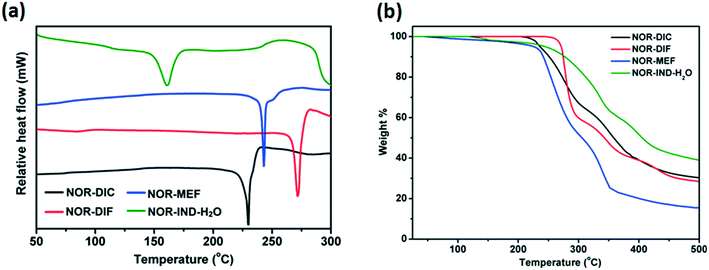 | ||
| Fig. 6 Thermal analysis of the multi-drug forms: (a) DSC thermograms and (b) TGA plots of all the multidrug salts and the salt hydrate. | ||
Solubility studies
Solubility is one of the most important parameters for any active pharmaceutical ingredient (API) to be formulated in a suitable dosage form. Solubility also affects the permeability and systemic absorption of an API, and thus impacts bioavailability.40,41 The solubility of any drug is dependent on various physicochemical properties like temperature, pH, and its dielectric constant and melting point, while the solubility of multicomponent systems like cocrystals and salts depends on a number of factors such as drug⋯coformer interactions, the individual concentrations of the coformers and the un-ionized drug in the solvent.42–44 It is well known that incorporation of highly soluble coformers into the binary crystals of APIs may lead to improvement of solubility. These coformers increase the dissolution rate of a sparingly soluble API by decreasing the solvation energy of multicomponent species.11,45 If both the components in a binary crystal suffer from low aqueous solubility, it could be that this compound will not show the solubility improvements often assigned in the formation of a binary crystal.In the present study, we have conducted extensive solubility measurements using the traditional shake-flask method (experimental details are given in the ESI†) to determine the equilibrium solubility of salts and the salt hydrate of norfloxacin (BCS class-IV drug) with different NSAIDs (BCS class-II drug) in different pH buffer solutions. Whether a drug is acidic or basic, most of its absorption occurs in the small intestine46 (pH 6–8) hence the solubility at pH 7.4 is more relevant. The solubility results were compared with those of pure drugs (Table S5, ESI†), and the residual solids were examined by PXRD. The results show that no form transformation occurred during the solubility experiment. Fig. 7 summarizes the solubility values of NOR in different salts in the pH 7.4 buffer solution. The solubility of NOR in the different salts (NOR–DIC, NOR–DIF, NOR–IND–H2O) was significantly improved, while the NOR solubility in the NOR–MEF salt was significantly reduced. One way ANOVA (p < 0.05) was applied to study the significant change in solubility of NOR in different salts using GraphPad Prism (Version 5, GraphPad software, Inc., California). The extent of solubility follows the order NOR–DIC > NOR–DIF > NOR–IND–H2O > NOR–MEF. The enhancement of solubility in the binary systems is likely due to the salt formation between the two drugs, as typically seen for pharmaceuticals.45,47 As shown in Fig. 7 and Table S5,† the equilibrium solubility of norfloxacin in NOR–DIC and NOR–DIF salts and the NOR–IND–H2O salt hydrate is enhanced 2.58, 1.36 and 1.47 folds, respectively, compared to the parent drug NOR (pure NOR has a solubility of 0.179 mg ml−1, which is from an earlier report).21 However, there is no significant increase in the solubility of NOR in the binary systems in the other two buffer solutions (pH 4.5 and pH 1.2, Fig. S13–S15 and Table S5 in the ESI†).
Permeability studies
The permeability of a drug across a biological membrane is the key factor in determining bioavailability. Poor permeability can lead to poor absorption across the gastrointestinal mucosa, as well as poor distribution throughout the body.48,49 The flux of a drug is defined as the amount of solid passing through a certain cross-sectional area of a biological membrane over a given period of time. In the present study, the diffusion behavior of the new multidrug salts and salt hydrate was studied using a modified Franz diffusion cell (for experimental details, see the ESI†) in pH 7.4 phosphate buffer at 1 h intervals for 8 h. An improved diffusion behavior was observed for the NOR–DIF salt and NOR–IND–H2O salt hydrate compared to the native drug norfloxacin except in the case of the NOR–DIC and NOR–MEF salts (Fig. 8). NOR–DIF salt and NOR–IND–H2O salt hydrate show a steady increase throughout the permeability experiment. Among all the multidrug salts and the salt hydrate, NOR–DIF is the potential candidate. At the end of the experiment, NOR–MEF exhibits several times better permeability than the parent drug. However, the comparative order of permeability is NOR–DIF > NOR–IND–H2O > NOR > NOR–DIC ≈ NOR–MEF.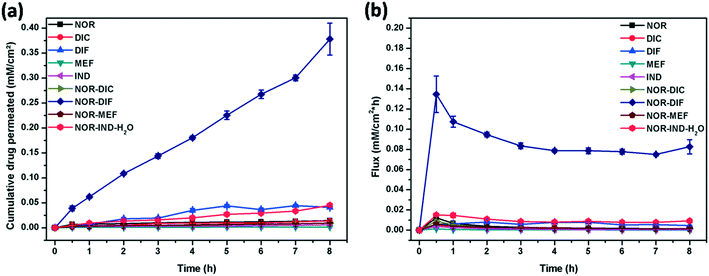 | ||
| Fig. 8 (a) Cumulative amount of NOR and the NOR_salts and salt hydrate diffused vs. time plot. (b) Flux of NOR_salts and salt hydrate vs. time. | ||
Conclusions
While searching for novel multidrug systems containing BCS class IV and class II candidates, three new multidrug salts of norfloxacin with diclofenac, diflunisal and mefenamic acid along with a salt hydrate of norfloxacin and indomethacin were obtained through a liquid-assisted grinding method followed by slow evaporation from the same solvent. The new solids were characterized well by SCXRD, thermal analysis (TGA and DSC), PXRD, and FT-IR spectroscopy. All multidrug crystals are sustained by piperazine–carboxylate synthons via N+–H⋯O− hydrogen bonding to form a rigid tetrameric R44 (12) ring. Their equilibrium solubilities in different biological pH media and membrane diffusivities were studied and compared with those of the parent drug as well. A significant solubility improvement of norfloxacin in the NOR–DIC and NOR–DIF salts and NOR–IND–H2O salt hydrate was observed in the pH 7.4 buffer medium along with increased permeability for the NOR–DIF salt and NOR–IND–H2O salt hydrate. Thus, considering our approach, among the salts of norfloxacin with NSAIDs, the NOR–DIF salt and NOR–IND–H2O salt hydrate hold great promise for pharmaceutical drug delivery applications due to their increased solubility and permeability and thus enhanced bioavailability. These could be great promising/potential candidates for further studies relevant to pharmaceutical industries. Thus, this work is consequential for the development of a new class of multidrug solids to overcome poor solubility and slow elimination issues of parent drugs.Conflicts of interest
The authors declare no competing financial interests.Acknowledgements
CMR gratefully acknowledges the financial assistance given by DST (DST/SJF/CSA-02/2014-15). The authors gratefully acknowledge the infrastructure facilities given by IISER Kolkata. B. B. (PDF/2016/000262) and K. B. R. (PDF/2015/000953) are thankful to DST-SERB, India for the National Postdoctoral Fellowship award.References
- G. R. Desiraju, J. Am. Chem. Soc., 2013, 135, 9952–9967 CrossRef CAS PubMed
.
-
G. R. Desiraju, J. J. Vittal and A. Ramanan, Crystal Engineering: A Textbook, World Scientific Publishing Company Inc, 2011 Search PubMed
.
-
Organic Crystal Engineering: Frontiers in Crystal Engineering, ed. E. R. T. Tiekink, J. J. Vittal and M. J. Zaworotko, John Wiley & Sons, 2010 Search PubMed
.
- T. Steiner, Angew. Chem., Int. Ed., 2002, 41, 48–76 CrossRef CAS
.
- G. R. Desiraju, Angew. Chem., Int. Ed. Engl., 1995, 34, 2311 CrossRef CAS
.
- S. Aitipamula, R. Banerjee, A. K. Bansal, K. Biradha, M. L. Cheney, A. R. Choudhury, G. R. Desiraju, A. G. Dikundwar, R. Dubey, N. Duggirala, P. P. Ghogale, S. Ghosh, P. K. Goswami, N. R. Goud, R. R. K. R. Jetti, P. Karpinski, P. Kaushik, D. Kumar, V. Kumar, B. Moulton, A. Mukherjee, G. Mukherjee, A. S. Myerson, V. Puri, A. Ramanan, T. Rajamannar, C. M. Reddy, N. Rodriguez-Hornedo, R. D. Rogers, T. N. Guru Row, P. Sanphui, N. Shan, G. Shete, A. Singh, C. C. Sun, J. A. Swift, R. Thaimattam, T. S. Thakur, R. K. Thaper, S. P. Thomas, S. Tothadi, V. R. Vangala, N. Variankaval, P. Vishweshwar, D. R. Weyna and M. J. Zaworotko, Cryst. Growth Des., 2012, 12, 2147–2152 CrossRef CAS
.
- S. A. Ross, D. A. Lamprou and D. Douroumis, Chem. Commun., 2016, 52, 8772–8786 RSC
.
- N. K. Duggirala, M. L. Perry, Ö Almarsson and M. J. Zaworotko, Chem. Commun., 2016, 52, 640–655 RSC
.
- D. Braga, F. Grepioni, G. I. Lampronti, L. Maini and A. Turrina, Cryst. Growth Des., 2011, 11, 5621–5627 CrossRef CAS
.
- G. Bolla and A. Nangia, Chem. Commun., 2016, 52, 8342–8360 RSC
.
- R. Thakuria, A. Delori, W. Jones, M. P. Lipert, L. Roy and N. Rodríguez-Hornedo, Int. J. Pharm., 2013, 453, 101–125 CrossRef CAS PubMed
.
- V. R. Vangala, P. S. Chow and R. B. H. Tan, CrystEngComm, 2013, 15, 878–889 RSC
.
- P. S. Chow, G. Lau, W. K. Ng and V. R. Vangala, Cryst. Growth Des., 2017, 17, 4064–4071 CrossRef CAS
.
- P. Sanphui, M. K. Mishra, U. Ramamurty and G. R. Desiraju, Mol. Pharmaceutics, 2015, 12, 889–897 CrossRef CAS PubMed
.
- G. R. Krishna, L. Shi, P. P. Bag, C. C. Sun and C. M. Reddy, Cryst. Growth Des., 2015, 15, 1827–1832 CrossRef CAS
.
- K. K. Sarmah, K. Boro, M. Arhangelskis and R. Thakuria, CrystEngComm, 2017, 19, 826–833 RSC
.
- N. Tumanova, N. Tumanov, K. Robeyns, F. Fischer, L. Fusaro, F. Morelle, V. Ban, G. Hautier, Y. Filinchuk, J. Wouters, T. Leyssens and F. Emmerling, Cryst. Growth Des., 2018, 18, 954–961 CrossRef CAS
.
- B. S. Sekhon, J. Pharm. Sci., 2012, 20, 45 CAS
.
- R. Thipparaboina, D. Kumar, R. B. Chavan and N. R. Shastri, Drug Discovery Today, 2016, 21, 481–490 CrossRef CAS PubMed
.
- S. Aitipamula, P. S. Chow and R. B. H. Tan, CrystEngComm, 2009, 11, 1823–1827 RSC
.
- S. P. Gopi, S. Ganguly and G. R. Desiraju, Mol. Pharmaceutics, 2016, 13, 3590–3594 CrossRef CAS PubMed
.
- A. O. Surov, A. P. Voronin, A. N. Manin, N. G. Manin, L. G. Kuzmina, A. V. Churakov and G. L. Perlovich, Mol. Pharmaceutics, 2014, 11, 3707–3715 CrossRef CAS PubMed
.
- R. Kaur, K. L. Cavanagh, N. Rodríguez-Hornedo and A. J. Matzger, Cryst. Growth Des., 2017, 17, 5012–5016 CrossRef CAS
.
- B. Harmsen and T. Leyssens, Cryst. Growth Des., 2018, 18, 441–448 CrossRef CAS
.
-
D. Taylor, The Pharmaceutical Industry and the Future of Drug Development, in Pharmaceuticals in the Environment, R. E. Hester and R. M. Harrison, The Royal Society of Chemistry, London, 2016, pp. 1–33 Search PubMed
.
-
M. Pudipeddi, A. T. M. Serajuddin, D. J. W. Grant and P. H. Stahl, Solubility and Dissolution of Weak Acids, Bases, and Salts, in Handbook of Pharmaceutical Salts, Properties, Selection and Use, ed. P. H. Stahl and C. G. Wermuth, Wiley-VCH, Weinheim, 1st edn, 2002, pp. 19–40 Search PubMed
.
- C. Almansa, R. Mercè, N. Tesson, J. Farran, J. Tomàs and C. PlataSalamán, Cryst. Growth Des., 2017, 17, 1884–1892 CrossRef CAS
.
- P. P. Bag, S. Ghosh, H. Khan, R. Devarapalli and C. M. Reddy, CrystEngComm, 2014, 16, 7393 RSC
.
- S. Prabodh Chander, J. Ankit and J. Sander, Acta Pol. Pharm., 2009, 66, 587–604 Search PubMed
.
- F. Van Bambeke, J. M. Michot, J. Van Eldere and P. M. Tulkens, Clin. Microbiol. Infect., 2005, 11, 256–280 CrossRef CAS PubMed
.
- N. M. Davies, A. J. McLachlan, R. O. Day and K. M. Williams, Clin. Pharmacokinet., 2000, 38, 225–242 CrossRef CAS PubMed
.
- G. C. Actis, R. Pellicano, M. Fadda and F. Rosina, Curr. Drug Saf., 2014, 9, 133–137 CrossRef CAS PubMed
.
-
BCS Classification, lassification, http://www.fda.gov/AboutFDA/CentersOffices/OfficeofMedicalProductsandTobacco/CDER/ucm128219.htm
.
- S. A. Breda, A. F. Jimenez-Kairuz, R. H. Manzo and M. E. Olivera, Int. J. Pharm., 2009, 371, 106–113 CrossRef CAS PubMed
.
- T. Takagi, C. Ramachandran, M. Bermejo, S. Yamashita, L. X. Yu and G. L. Amidon, Mol. Pharmaceutics, 2006, 3, 631–643 CrossRef CAS PubMed
.
- O. D. Putra, T. Furuishi, E. Yonemochi, K. Terada and H. Uekusa, Cryst. Growth Des., 2016, 16, 3577–3581 CrossRef CAS
.
- O. V. Dolomanov, L. J. Bourhis, R. J. Gildea, J. A. K. Howard and H. Puschmann, J. Appl. Crystallogr., 2009, 42, 339–341 CrossRef CAS
.
- L. Palatinus and G. Chapuis, J. Appl. Crystallogr., 2007, 40, 786–790 CrossRef CAS
.
- G. M. Sheldrick, Acta Crystallogr., Sect. A: Found. Crystallogr., 2008, 64, 112–122 CrossRef CAS PubMed
.
- A. Dahan, J. M. Miller, A. Hoffman, G. E. Amidon and G. L. Amidon, J. Pharm. Sci., 2010, 99, 2739–2749 CrossRef CAS PubMed
.
- J.
M. Miller and A. Dahan, Int. J. Pharm., 2012, 430, 388–391 CrossRef CAS PubMed
.
- S. Gutsche, M. Krause and H. Kranz, Drug Dev. Ind. Pharm., 2008, 34, 1277–1284 CrossRef CAS PubMed
.
- A. Alhalaweh, L. Roy, N. Rodríguez-Hornedo and S. P. Velaga, Mol. Pharmaceutics, 2012, 9, 2605–2612 CrossRef CAS PubMed
.
- G. Kuminek, N. Rodríguez-Hornedo, N. S. Siedler, H. V. A. Rocha, S. L. Cuffini and S. G. Cardoso, Chem. Commun., 2016, 52, 5832–5835 RSC
.
- A. T. M. Serajuddin, Adv. Drug Delivery Rev., 2007, 59, 603–616 CrossRef CAS PubMed
.
-
N. Washington, C. Washington and C. Wilson, Physiologicalpharmaceutics: Barriers to drug absorption, CRC Press, 2nd edn, 2001, p. 82 Search PubMed
.
-
O. I. Corrigan, Salt Forms: pharmaceutical aspects, in Encyclopedia of pharmaceutical technology, ed. J. Swarbrick and J. C. Boylan, Marcel Dekker, New York, 2nd edn, 2002 Search PubMed
.
- D. F. Veber, S. R. Johnson, H. Y. Cheng, B. R. Smith, K. W. Ward and K. D. Kopple, J. Med. Chem., 2002, 45, 2615–2623 CrossRef CAS PubMed
.
- I. Gomez-Orellana, Expert Opin. Drug Delivery, 2005, 2, 419–433 CrossRef CAS PubMed
.
Footnote |
| † Electronic supplementary information (ESI) available: The figures related to the IR, DSC and PXRD patterns of the compounds along with different structural figures and tables related to the crystal structures reported in this paper and the experimental details of solubility and membrane permeability studies are available. CCDC 1823915–1823918. For ESI and crystallographic data in CIF or other electronic format see DOI: 10.1039/c8ce00900g |
| This journal is © The Royal Society of Chemistry 2018 |

